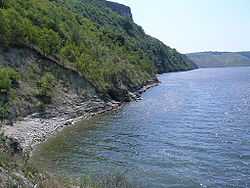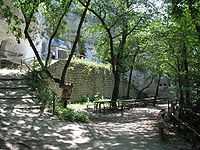Bakota, Ukraine
| Bakota Ба́кота | |
|---|---|
| Historic settlement | |
 | |
 Bakota | |
| Coordinates: 48°35′35″N 26°58′44″E / 48.59306°N 26.97889°ECoordinates: 48°35′35″N 26°58′44″E / 48.59306°N 26.97889°E | |
| Country |
|
| Oblast |
|
| Raion |
|
| First mentioned | 1240[1] |
| Elevation[2] | 110-130 m (360-426 ft) |
| Time zone | EET (UTC+2) |
| • Summer (DST) | EEST (UTC+3) |
Bakota (Ukrainian: Ба́кота) is a historic submerged settlement of the Rus Kingdom, modern-day Khmelnytskyi Oblast (province) in western Ukraine. The village lies beneath the Dniester River and is located in the historical Podillia region.
Bakota has an ancient Orthodox cave monastery (48.585647°N, 26.999702°E), which includes ancient frescoes and paintings dating back to the 12th-14th centuries,[1] as well as preserved remains of monks.[3] Local legend has it that the Bakota Cave Monastery was founded by Saint Anthony of Kiev, who also founded the historic Kiev Pechersk Lavra in 1051, now in Kiev, Ukraine.[4] A Paleolithic archaeological site is also located near the village.[1] Bakota is currently part of the National Environmental Park "Podilski Tovtry".
Faina Melnyk, an Ukrainian discus thrower of Jewish descent and a 1972 gold medal champion in the discus event, was born in the village in 1945.[5]
History
Bakota was first mentioned in the Hypatian Chronicle in the year 1240.[1] When the town was first settled, the town was part of the state of Kievan Rus', until the middle of the 12th century when it became a part of the Halych-Volhynian Kingdom.[6] In the 13th century, Bakota served as the political and administrative center of the Dniester Lowland (Ponyzzia), which was at the time part of Halych-Volhynia.[3] The chronicle also mentions the rule of the Koriatovych dynasty over the area in 1362.[4]

After being ruled by the Koriatovych dynasty, the town was controlled by Algirdas, a monarch of the medieval Grand Duchy of Lithuania.[6] The Lithuanian Chronicle of 1362 mentions that a functioning cave monastery exists within the town.[6] This motivated the construction of fortifications, to protect the town from Crimean Tatar raids.[6] In 1431, Bakota was located and shared between the Grand Duchy of Lithuania and the Kingdom of Poland. Bakota's inhabitants later started a revolt and proclaimed their independence, which was crushed by Poland within three years[6] The town's fortifications and castle were also destroyed.[6]
In 1893, in place of a formerly standing church, a new wooden one was constructed, founded by the Episcop of Podillia and Bratslav Dmitry.[4][7] The church was destroyed in 1960. On October 27, 1981, the village of Bakota was flooded when the New Dniester Hydroelectric Station was built.[8] The village's inhabitants were moved from the area and re-settled not far away. In 1996, large portions of Bakota's rocky hills broke off and buried most of the village's ancient caves.[8]
Notable residents
- Faina Melnyk, Olympic champion discus thrower
References
- ↑ 1.0 1.1 1.2 1.3 "Bakota". Encyclopedia of Ukraine. Retrieved 2007-10-07.
- ↑ "Bakota". nebo.kiev.ua (in Russian). Archived from the original on 2007-08-14. Retrieved 2007-10-07.
- ↑ 3.0 3.1 "Khmelnytskiy (1493, 260.1 inhabitants)". Magistral (in Russian). Archived from the original on 12 October 2007. Retrieved 2007-10-07.
- ↑ 4.0 4.1 4.2 Kuzin, Volodymyr. "Bakota". castles.com.ua (in Ukrainian). Archived from the original on 11 October 2007. Retrieved 2007-10-07.
- ↑ "Faina Melnik". sporting-heroes.net. Archived from the original on 13 November 2007. Retrieved 2007-10-07.
- ↑ 6.0 6.1 6.2 6.3 6.4 6.5 "Bakota". Architectural and environmental Monuments of Ukraine (in Ukrainian). Archived from the original on 27 October 2007. Retrieved 2007-10-07.
- ↑ "Rock monastery, end of 13-middle 14th c." in "Monuments of architecture of Ukrainian SSR," edited by N. L. Zharikov, Kiev, "Budivelʹnyk", 1983-1986, LCCN 84-179019 (Russian)
- ↑ 8.0 8.1 "Bakota". Russian Wikipedia (in Russian). Retrieved 2007-10-07.
External links
| Wikimedia Commons has media related to Bakota. |
- "Cave monastery. 14th century. Item №1686". National Environmental Park "Podilski Tovtry" (in Russian). Archived from the original on 11 November 2007. Retrieved 2007-10-07.
- "Rock-cave Sviaty-Mykhailivskyi Monastery". bakota.narod.ru (in Ukrainian). Archived from the original on 25 August 2007. Retrieved 2007-10-07.